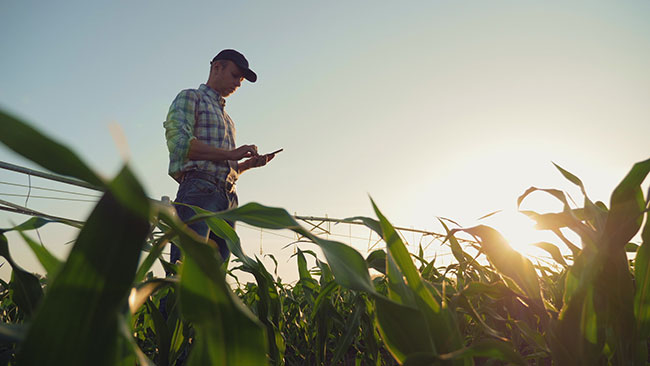
Features
A.I. influencing trends in agricultural engineering
December 5, 2023 by Chris McCullough
 Automation and connection are the new reality when it comes to farming equipment.
Photo: © DiedovStock / adobe stock
Automation and connection are the new reality when it comes to farming equipment.
Photo: © DiedovStock / adobe stock Every day, manufacturers of farm machinery seem to be launching new equipment of concepts that they hope will enter commercial production at some stage.
The demands asked of these machines have changed quickly over the past 20 years and will evolve with even more pace over the next 20.
As governments react to consumer requests, they are constantly changing the playing fields making farmers jump through hoops to comply with never-ending legislation.
This is evident regarding emissions produced by the agricultural sector and how targets set by governments to reduce them on individual farms are causing huge issues.
Meanwhile, the machinery manufacturers roll out new technology, which is often guided by Artificial Intelligence (A.I.), to help farms become more efficient and productive.
A magnitude of tasks are covered under the AI umbrella, but mostly it involves the creation of data, the harvesting and subsequent processing of that data, and the development of technology to harness it.
So what does all this mean? Sensors, satellites, cameras and other tech essentially record data, should it be from livestock, tractors, milking robots, etc., which influences future trends in machinery.
One of the biggest trend changes is that of switching diesel use in tractors to alternative sources such as methane, electricity, HVO and hydrogen.
In the area of gas engines, LNG engine concepts can now also advance to become a suitable drive option in farming thanks to new LNG tanks.
Battery technology is constantly being evolved, but vehicles equipped with this are first and foremost likely to be suitable for light and medium-duty applications.
Conversely, fuel cell drives are still in their infancy, whereas hybrid models might be a solution for medium or larger tractors.
Manufacturers of combine harvesters are continually developing innovations in threshing and separating as well as for ensuring performance stability and work quality.
Power density with limited installation space and automation are continuing to increase. The trend towards harvesting headers such as belt cutting systems that can be adapted to diverse conditions is continuing.
Considering fertiliser technology, the trend towards increasing efficiency, environmental protection and resource conservation is continuing in order to ensure the most efficient fertiliser application with the lowest possible nutrient loss.
One essential element of further developments is the integration of automation technology and simplifications in the operation and control of the application systems.
There are numerous new and further developments in this regard in the area of centrifugal and pneumatic fertiliser spreaders and the application of liquid and solid farm manure.
Seeding machinery technology has advanced to ensure uniform seed bed preparation and consistent seed depth placement are part of their operation.
Row seeding systems with singling and also precision seeding systems are gaining in importance. This year, automatic coulter pressure adjustment is an additional topic for innovations in row seeding. Another innovation trend is the simultaneous application of seed in order to meet the requirements for multiple crops on the field.
Sprayers are getting larger and their technology more sophisticated, with spot applications becoming more popular. However, as governments drive down the use of chemicals more mechanical weeding machines are also being introduced to the market.
For potato farmers, optoelectronic sorting systems are increasingly being used in the preparation of ware potatoes. In the case of combined units consisting of soil tillage, planting and ridging tools, the separate adjustment or use of the assemblies facilitates adaptation to changing operating conditions during potato field cultivation.
Silage equipment has also been revolutionised over the years according to its intended use and at increasingly relieving the drivers’ workload. This includes front-mounted mower control that is adjusted to the inclination and curve as well as automatic mower conditioner adjustment.
The cutting qualities of self-loading trailers are aimed at a lower percentage of excessive lengths. The objective of round balers with a variable bale chamber is bales with the same dry matter content while the goals of forage harvesters are consistent cutting qualities and a very high throughput. Dimensionally stable, gas-tight round bales remain the ultimate goal for nets and wrapping films.
Digital technology is becoming used much more in farming systems with innovations ranging from tramline planning and machine automation and from management systems and apps to irrigation, crop protection and fertilisation management.
Focus is usually placed on the optimisation of entire production systems while increasing work performance and quality at the same time. The trend towards cross-manufacturer solution approaches is clearly recognisable.
With less land available each year to grow food and the world population on a steady increase, farmers know they have to grow more with less.
This is where the machinery manufacturers can excel by developing equipment that can work faster, harder, smarter, use less fuel and be more efficient.
Electric drives are improving the machines’ dynamics and reducing their CO2 emissions. The increased use of cameras and other sensors in combination with intelligent evaluation is making operation of the machines and implements easier and is ensuring a consistently high quality of work thanks to assistance systems and automation.
It sure will be interesting to see what type and size of machines farmers will be using to produce food in the next
to decades.
The big question will be if your mobile phone can hold any more apps! •